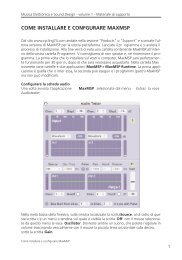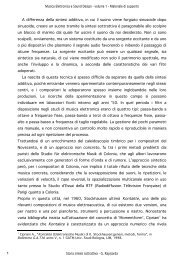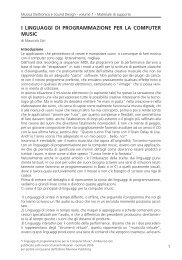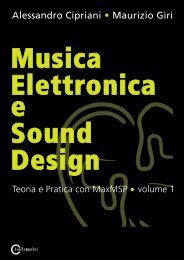programming with max/msp - Virtual Sound
programming with max/msp - Virtual Sound
programming with max/msp - Virtual Sound
You also want an ePaper? Increase the reach of your titles
YUMPU automatically turns print PDFs into web optimized ePapers that Google loves.
Chapter 3T - Noise generators, filters, and subtractive synthesis<br />
3.1 SOUND SOURCES FOR SUBTRACTIVE SYNTHESIS<br />
In this chapter we will discuss filters, a fundamental subject in the field<br />
of sound design and electronic music, and subtractive synthesis, a widelyused<br />
technique that uses filters. A filter is a signal processing device that<br />
acts selectively on some of the frequencies contained in a signal, applying<br />
attenuation or boost to them. 1 The goal of most digital filters is to alter the<br />
spectrum of a sound in some way. Subtractive synthesis was born from<br />
the idea that brand-new sounds can be created by modifying, through the<br />
use of filters, the amplitude of some of the spectral components of other<br />
sounds.<br />
Any sound can be filtered, but watch out: you can’t attenuate or boost components<br />
that don’t exist in the original sound. For example, it doesn’t make<br />
sense to use a filter to boost frequencies around 50 Hz when you are filtering<br />
the voice of a soprano, since low frequencies are not present in the original<br />
sound.<br />
In general, the source sounds used in subtractive synthesis have rich spectra<br />
so that there is something to subtract from the sound. We will concentrate on<br />
some of these typical source sounds in the first portion of this section, and we<br />
will then move on to a discussion of the technical aspects of filters.<br />
Filters are used widely in studio work, and <strong>with</strong> many different types of<br />
sound:<br />
> <strong>Sound</strong>s being produced by noise generators, by impulse generators, by<br />
oscillator banks, or by other kinds of signal generators or synthesis<br />
> Audio files and sampled sounds<br />
> <strong>Sound</strong>s being produced by live sources in real time (the sound of a musician<br />
playing an oboe, captured by a microphone, for example)<br />
NOISE GENERATORS: WHITE NOISE AND PINK NOISE<br />
One of the most commonly used source sounds for subtractive synthesis is<br />
white noise, a sound that contains all audible frequencies, whose spectrum<br />
is essentially flat (the amplitudes of individual frequencies being randomly<br />
distributed). This sound is called white noise in reference to optics, where the<br />
color white is a combination of all of the colors of the visible spectrum. White<br />
noise makes an excellent source sound because it can be meaningfully filtered<br />
by any type of filter at any frequency, since all audible frequencies are present.<br />
(A typical white noise spectrum is shown in Figure 3.1.)<br />
1 Besides altering the amplitude of a sound, a filter modifies the relative phases of its components.<br />
from “Electronic Music and <strong>Sound</strong> Design” Vol. 1 by Alessandro Cipriani and Maurizio Giri<br />
© ConTempoNet 2010 - All rights reserved<br />
3T<br />
295







